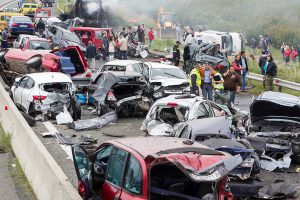Who Is To Blame For A Multi-Vehicle Accident In Florida?
 Michael Babboni
Car Accidents
As residents of St. Pete’s for decades, we have loved seeing how our city has grown over the years. However, one part of growth that we can all agree is no fun is the increasing amount of traffic. It seems nearly every day there’s a multi-car pileup, especially along Interstate 275 during rush hour. Beyond just being extremely dangerous, these pileups are legally complex and often times accident victims do not get the settlement they deserve to cover their injuries damages.
Michael Babboni
Car Accidents
As residents of St. Pete’s for decades, we have loved seeing how our city has grown over the years. However, one part of growth that we can all agree is no fun is the increasing amount of traffic. It seems nearly every day there’s a multi-car pileup, especially along Interstate 275 during rush hour. Beyond just being extremely dangerous, these pileups are legally complex and often times accident victims do not get the settlement they deserve to cover their injuries damages.What Is A Multi-Vehicle Accident?
Most of the time, when we talk about multi-vehicle accidents, we think of the chain collision. These tend to only occur on interstates and freeways where the traffic is congested and people drive at higher speeds. In a multi-vehicle accident, what typically happens is one car rear ends another on the highway and the cars behind do not have time to stop and they also rear end the vehicle in front of them. In St. Pete’s we’ve had multi-vehicle crashes along the interstate with six cars hit each other in a row. A multi-vehicle accident can also cause the drivers in the back to swerve to avoid hitting the person in front of them, leading to a crash into the rails, in a ditch, or a vehicle in the side lanes.
Who Is At Fault For A Multi-Vehicle Accident?
Typically, the driver who rear-ends a vehicle is usually at fault for the accident. This is because legally, all drivers are required to leave reasonable space between their vehicle and the vehicle in front of them. By not leaving this space, they are reducing their reaction time to stops and are therefore at fault for any collision. However, this legal guideline becomes more complex in a pileup. If you rear-end the person in front of you because you were rear-ended, are you considered at fault? Depending on the situation, you may be or the driver behind you may be at fault for both collisions.
How Fault In A Multi-Vehicle Accident Works In Florida
In the state of Florida, fault is determined through a system caused comparative fault. Comparative fault means that the insurance companies and courts look at the circumstances of an accident and assign fault based on percentages. For example if you are the middle care in a pileup, you may not be 100% responsible for the accident, but you may be found 10% responsible if investigators find you didn’t leave enough distance from the vehicle in front of you. In that cause, you’d be 10% responsible for the damages for the car in front of you.
How Fault Is Determined
There are many ways to determine fault after a multi-vehicle accident. Insurance agencies, attorneys, and courts typically consider:
● Details revealed in surveillance footage, the police report, and witness testimony
● What each driver was doing at the time of the accident
● An overview of the conditions of the road and traffic that day
● Medical evidence that suggests how the injuries may have occurred
● A review of the skid marks on the road and tire damage of each vehicle to determine the stopping pattern
● Any other factors including mechanical issues, weather, or the presence of animals
Every accident is different, so the more information and evidence collected, the more clearly a determination of fault can be made. Thus the process can take a long time.
Navigating the legal complexities of a multi-vehicle pile up is challenging for the average person and insurance companies know this. So they will try everything they can to unfairly assign blame to get out of paying for your damages. The best defense you have is with the help of a knowledgeable attorney who can gather all the evidence and fight to assign fault to the negligent party. Michael Babboni has nearly 30 years of experience helping auto accident victims in St. Pete’s. If you’ve been in a multi-car accident, give him a call at (727) 381-9200 for a free consultation and to learn how he can help you.
